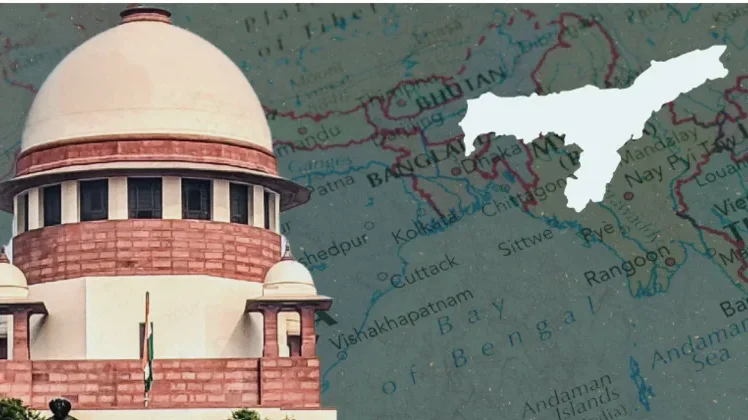SC UPHOLDS THE VALIDITY OF THE SECTION 6A OF CITIZENSHIP ACT, 1955

Oct. 12, 2025 • Yashaswi Singhal
Student's Pen
The Supreme Court upheld the constitutionality of Section 6A of Citizenship Amendment Act, 1985 by a majority of 4:1. The majority opinion was headed by CJI D.Y. Chandrachud and the dissenting opinion was given by Justice J.B. Pardiwala.
BCKGROUND
The Section 6A of the Citizenship Amendment Act, of 1985 deals with the conferment of citizenship rights to persons covered by the Assam Accord. It classifies migrants into two categories:
- Entered Assam before 1 January 1966
- Entered Assam after 1 January 1966 but before 25 March 1971
The migrants encompassed under the first category and have been ordinarily residing in the country since their date of entry are deemed to be citizens of the country from 1 January 1966.
While the migrants referred under the second category have to register themselves and undergo a waiting period of 10 years. During the period they shall have the rights and obligations of an ordinary Indian citizen but do not have the right to vote before the expiration of such period. The migrants who entered the territory of Assam after 25 March 1971 are deemed to be illegal and shall be detected and deported. The section was challenged on various grounds including its constitutionality under Articles 6,7,11,14 of the Indian Constitution.
JUDICIAL QUESTIONS RAISED
The main questions raised in the petition include whether Article 11 confers the parliament with the power to “alter” provisions concerning citizenship, whether section 6A alters or amends the effect of Articles 6 and 7, and whether it is in violation of Article 14 for adopting an unreasonable date and singles out the state of Assam.
First of all, Article 11 states that the state shall not derogate from making any provision with respect to acquisition and termination of citizenship and all other matters relating to citizenship. This article directly corresponds to the parliament's ability to alter provisions relating to citizenship; hence, the alterations in the current act are under the constitutional ambit.
Articles 6 and 7 deal with the conferment of citizenship rights to migrants from India and Pakistan during partition. Article 6 provides citizenship rights from the commencement of the constitution, whereas Section 6A provides citizenship rights from a later date to those who are not covered by Articles 6 and 7. The court held that section 6A of the Citizenship Act does not have the effect of amending Articles 6 and 7.
Article 14 has a concept of intelligible differentia which states that there shall be a rational basis for division or classification and such division or classification needs to have a reasonable nexus with the main objective of such classification. In the present situation, two yardsticks have been found for the differentiation or classification,
- Migrants must have entered Assam
- Such entry shall be before the cut-off date of 25 March 1971
The main objective for the division was to deal with the influx of migrants in Assam and it deals and balances the humanitarian needs of the migrants and their impact on the economic and cultural needs of the Indian States. There seems to be a close nexus between the yardsticks propounded and the objective established, hence Section 6A is in consonance with Article 14 of the constitution.
DISSENTING OPINION:
Justice J.B. Pardiwala in his dissenting opinion declared the impugned section unconstitutional from a prospective effect i.e. unconstitutional from the date of judgment. He reasoned that the number of foreigners detected under the provision were far lower than the correct number of immigrants that arrived during the period. This was attributed to inherent arbitrariness and lack of implementation in the Section 6A.
There have been various instances in the proceedings criticizing the lack of implementation of the provision and proving that it’s mechanism was inadequate to cater to the problem in question. For example, the tribunals responsible for the identification of illegal migrants are not sufficient. The court has been asked to constitute a bench to overlook the ongoing process as judicial oversight is deemed necessary for proper and smooth implementation of Section 6A.
CONCLUSION:
This judgment solves an essential problem relating to the grant of citizenship to the influx of migrants in the north-eastern borders due to humanitarian crises in their own countries. It creates a distinction between those who can avail the citizenship rights as a concern for their humanitarian rights from those who are not eligible to avail so due to the need to grant protection to the state’s culture and economy from heavy influx of migrants. It reaffirms India’s commitment to protecting those displaced from the Bangladesh Liberation War of 1971. This judgment will form a basis for upcoming judgments and will act as a rational precedent.
REFERENCES: